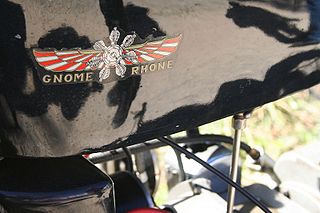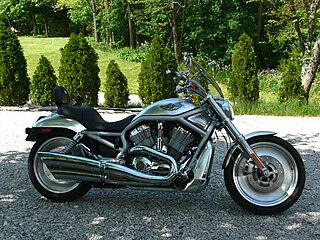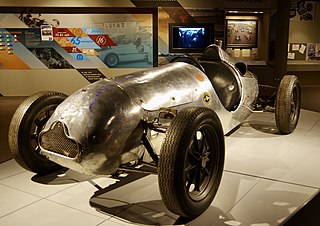
Cosworth is a British automotive engineering company founded in London in 1958, specialising in high-performance internal combustion engines, powertrain, and electronics; for automobile racing (motorsport) and mainstream automotive industries. Cosworth is based in Northampton, England, with American facilities in Indianapolis and Mooresville, North Carolina.

The straight-six engine is an internal combustion engine, with six cylinders mounted in a straight line along the crankcase with all the pistons driving a common crankshaft.

Allard Motor Company Limited was a London-based low-volume car manufacturer founded in 1945 by Sydney Allard in small premises in Clapham, south-west London. Car manufacture almost ceased within a decade. It produced approximately 1900 cars before it became insolvent and ceased trading in 1958. Before the war, Allard supplied some replicas of a Bugatti-tailed special of his own design from Adlards Motors in Putney.

Velocette is a line of motorcycles made by Veloce Ltd, in Hall Green, Birmingham, England. One of several motorcycle manufacturers in Birmingham, Velocette was a small, family-owned firm, selling almost as many hand-built motorcycles during its lifetime, as the mass-produced machines of the giant BSA and Norton concerns. Renowned for the quality of its products, the company was "always in the picture" in international motorcycle racing, from the mid-1920s through the 1950s, culminating in two World Championship titles and its legendary and still-unbeaten 24 hours at over 100 mph (161 km/h) record. Veloce, while small, was a great technical innovator and many of its patented designs are commonplace on motorcycles today, including the positive-stop foot shift and swinging arm rear suspension with hydraulic dampers. The business suffered a gradual commercial decline during the late 1960s, eventually closing in February 1971.

Singer Motors Limited was a British motor vehicle manufacturing business, originally a bicycle manufacturer founded as Singer & Co by George Singer, in 1874 in Coventry, England. Singer & Co's bicycle manufacture continued. From 1901 George Singer's Singer Motor Co made cars and commercial vehicles.

Austin Motor Company's small straight-4 automobile engine, the A series, is one of the most common in the world. Launched in 1951 with the Austin A30, production lasted until 2000 in the Mini. It used a cast-iron block and cylinder head, and a steel crankshaft with 3 main bearings. The camshaft ran in the cylinder block, driven by a single-row chain for most applications, and with tappets sliding in the block, accessible through pressed steel side covers for most applications, and with overhead valves operated through rockers. The cylinder head for the overhead-valve version of the A-series engine was designed by Harry Weslake – a cylinder head specialist famed for his involvement in SS (Jaguar) engines and several F1-title winning engines. Although a "clean sheet" design, the A series owed much to established Austin engine design practise, resembling in general design and overall appearance a scaled-down version of the 1200cc overhead-valve engine first seen in the Austin A40 Devon which would form the basis of the later B-series engine.

Gnome et Rhône was a major French aircraft engine manufacturer. Between 1914 and 1918 they produced 25,000 of their 9-cylinder Delta and Le Rhône 110 hp (81 kW) rotary designs, while another 75,000 were produced by various licensees. These engines powered the majority of aircraft in the first half of the war, both Allied designs as well as German examples produced by Motorenfabrik Oberursel.

JA Prestwich Industries, was a British engineering equipment manufacturing company named after founder John Alfred Prestwich, which was formed in 1951 by the amalgamation of J.A.Prestwich and Company Limited and Pencils Ltd.

Matchless is one of the oldest marques of British motorcycles, manufactured in Plumstead, London, between 1899 and 1966. A wide range of models were produced under the Matchless name, ranging from small two-strokes to 750 cc four-stroke twins. Matchless had a long history of racing success; a Matchless ridden by Charlie Collier won the first single-cylinder race in the first Isle of Man TT in 1907.
HRD Motors Ltd was a British motorcycle manufacturer in the 1920s. It was founded by Howard Raymond Davies. He had worked in motorcycling, and had raced with some success in the mid-twenties, but often not finishing due to unreliability. This inspired him to build a reliable performance motorcycle, using the advertising slogan "Built by a rider". Others also aimed at a similar market, like George Brough of Brough Superior motorcycles.

The BSA Gold Star is a motorcycle made by BSA from 1938 to 1963. They were 350 cc and 500 cc single-cylinder four-stroke production motorcycles known for being among the fastest bikes of the 1950s. Being hand built and with many optional performance modifications available, each motorcycle came from the factory with documented dynamometer test results, allowing the new owner to see the horsepower (bhp) produced.
Rex, Rex Motorcycles, Rex-Acme, was a car and motorcycle company which began in Birmingham, England in 1900. Rex soon merged with a Coventry maker of bicycles and cars named Allard and then later in 1922 the company merged with Coventry's 'Acme' motorcycle company forming 'Rex Acme'. The company existed until 1933, and, in its heyday, was considered one of the greatest names in the British motorcycle industry.

The Harley-Davidson VRSC, or V-Rod, is a line of V-twin cruiser motorcycles made by Harley-Davidson from 1999 until 2017. They are often called muscle bikes for their relatively high power output. The V-Rods are the first Harley-Davidson street motorcycles with double overhead camshafts (DOHC) and liquid cooling.

The Cooper Mark IV was a Formula Three and Formula Two racing car designed and built by the Cooper Car Company at Surbiton, Surrey, England, in 1950.

Charles Newton "Charlie" Cooper was a British motorsport mechanic, designer and entrepreneur.

The Standard SC engine is a cast-iron overhead valve straight-four engine designed and initially produced by Standard Triumph. Over its production life displacement grew from an initial size of just over 800 cc to nearly 1500 cc. Introduced in the Standard Eight in 1953, it would eventually be used in a wide range of vehicles from Standard, Triumph, and MG.
The Cooper Mk.V, is a series of three different Formula 3 cars, designed, developed and built by Cooper Cars in 1951. Like its predecessor, it used a 500 cc (31 cu in) JA Prestwich Industries (JAP) single-cylinder engine, or a 1,000–1,100 cc (61–67 cu in) JA Prestwich Industries (JAP) V-2 engine. The first version was the short-wheelbase Cooper T15; which featured a box-section chassis frame, detachable body panels, and a rack-and-pinion steering system. The second version was the long wheelbase Cooper T16, which featured a lengthened wheelbase to be able to equip the larger 1 L (61 cu in) engine. And the third and final version, the Cooper T17; which was a special streamliner version land speed record attempt car for speed record attempts, and sometimes, used for fast road racing circuits.

The Cooper Mk.VIII is a Formula 3 car built by British manufacturer Cooper Cars in 1954. It came in three different versions. The first was the Cooper T31; which featured a curved tubular chassis, a revised transmission housing, a central scuttle tank, a "curled-leaf" spring, and a 500 cc (31 cu in) JA Prestwich Industries (JAP) single-cylinder engine. The second version was the Cooper T32; which featured an elongated chassis and body, and a larger and more powerful 1,100 cc (67 cu in) OHV V-2 engine. The third and final iteration was the Cooper T28; which was a streamliner designed for setting speed records.

The Cooper Mark II, also known as the T5 , was a 500cc open-wheel racing car designed and built by the Cooper Car Company at Surbiton, Surrey, England, in 1948, and was the first production car made by Cooper. It was a successor to 1946 Cooper 500, which was a prototype. 12 cars were built. It was powered by a 45 hp (34 kW) 500 cc (31 cu in) JA Prestwich Industries (JAP) 4B Speedway single-cylinder engine, but had the option of being converted to a lengthened wheelbase version, to be able to use a 70 hp (52 kW) 1,000 cc (61 cu in) JA Prestwich Industries (JAP) or Vincent-HRD V-twin. It also notably won the first ever Grand Prix at Silverstone in 1948, competing in the 500 cc class, being driven by Spike Rhiando.

The Cooper 500, also referred to as the T2/T3 , was a prototype 500cc open-wheel racing car designed and built by the Cooper Car Company in Surbiton, Surrey, England, and was their first ever car. The first post-war prototypes were built in 1946, shortly after the end of the Second World War. Since materials were in short supply immediately after World War II, the prototypes were constructed by joining two old Fiat Topolino front-ends together. It was powered by a 45 hp (34 kW) 500 cc (31 cu in) JA Prestwich Industries (JAP) 4B Speedway single-cylinder motorcycle engine, which drives the rear wheels through a Triumph Speed Twin gearbox, via chain. It was succeeded by their first successful production car, the Mk.II, in 1948.

















